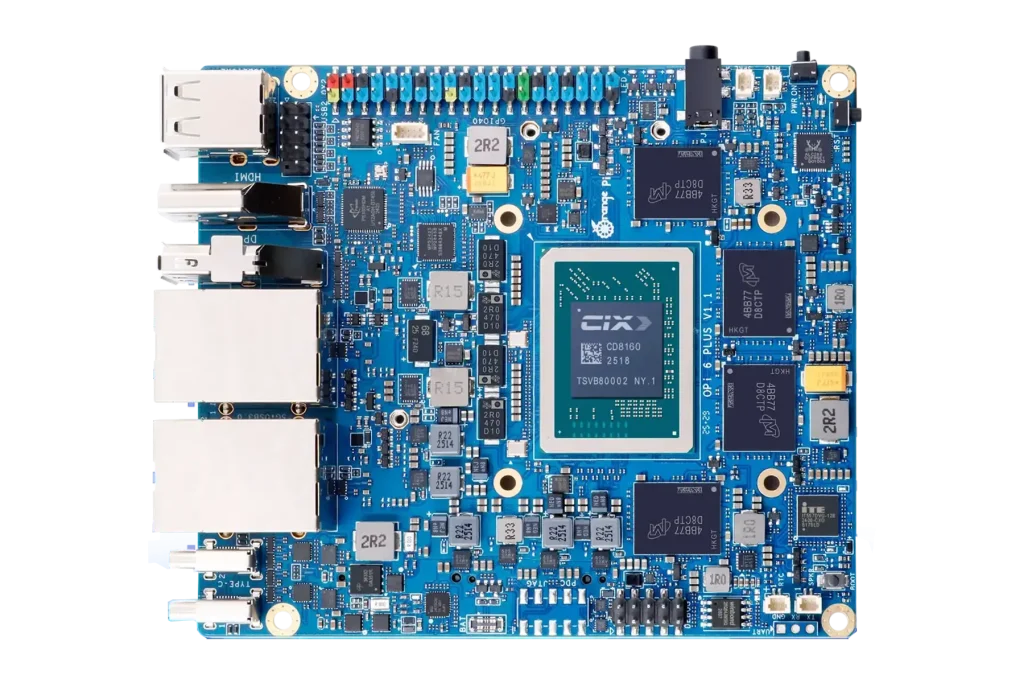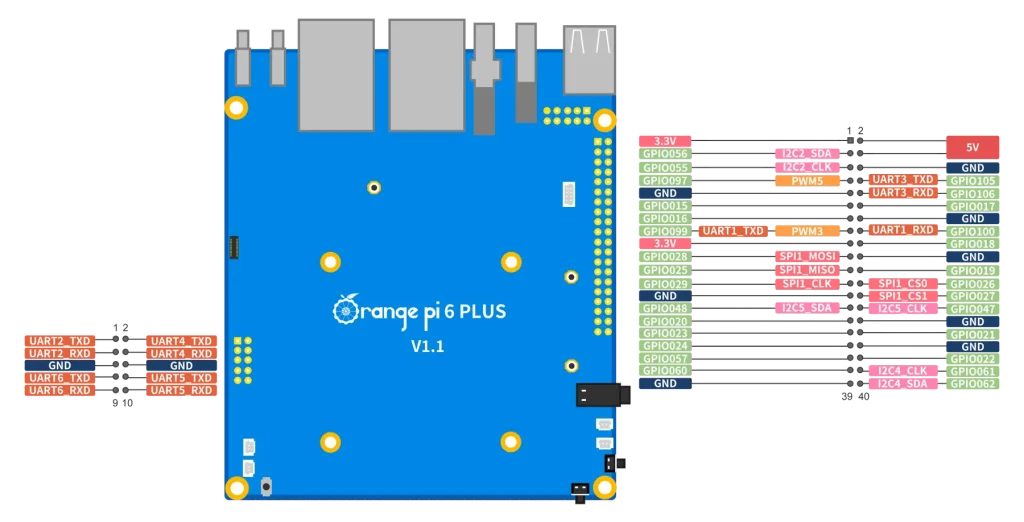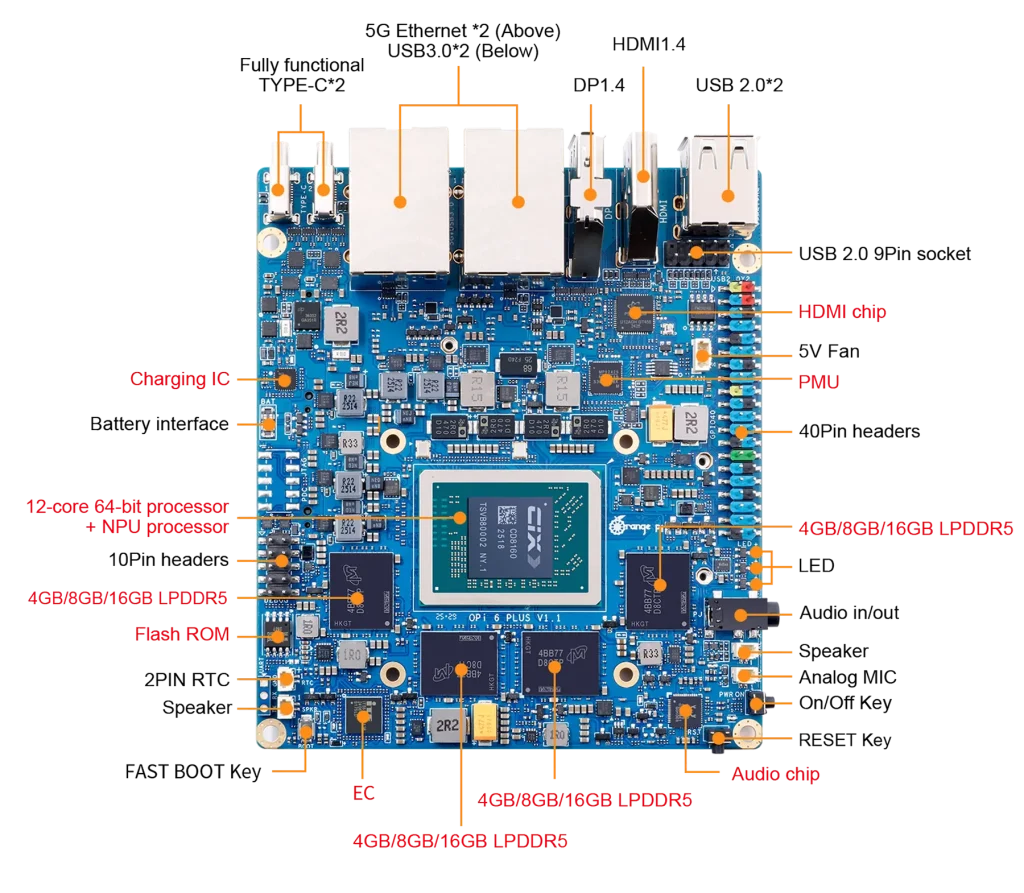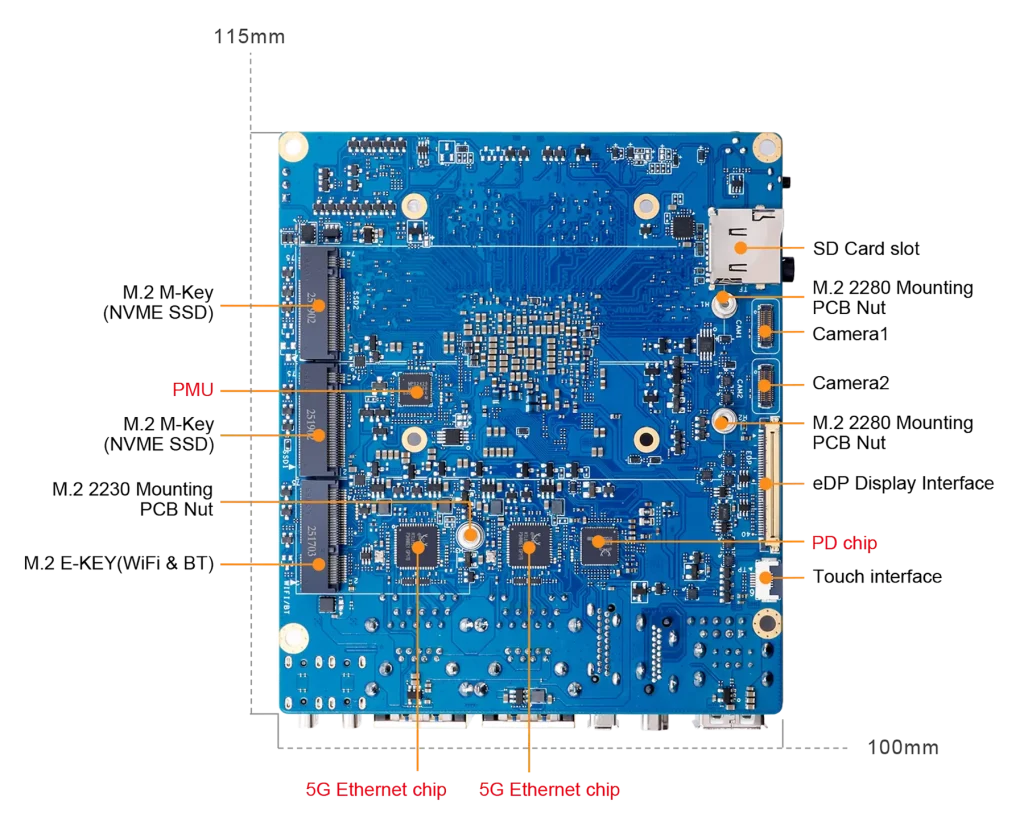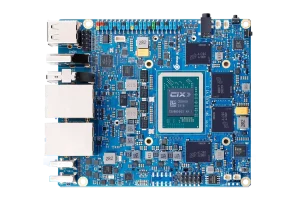If you’re choosing between the two Orange Pi 6 Plus vs Orange Pi 5 Plus, you’re asking the right question. Below is a clear, beginner-friendly, yet technically thorough comparison that shows exactly how these single-board computers differ in CPU/GPU/NPU, memory and storage options, I/O, real-world performance, price, and use cases.
Orange Pi’s “Plus” models target heavier workloads than the tiny hobbyist boards: think desktop replacement, media centers, edge AI, or compact servers. The Orange Pi 5 Plus (Rockchip RK3588 family) arrived earlier as a high-end 8-core RK3588 board. The Orange Pi 6 Plus is a later generation SBC that targets higher raw CPU throughput and on-board NPU/AI acceleration with a newer 12-core CIX/Codename (CD8xxx) family SoC and LPDDR5 memory options. Below I break down what that means for you — feature by feature. Orange Pi+1
-
Choose Orange Pi 6 Plus if you want newer CPU architecture, much stronger on-board NPU for local AI, LPDDR5 memory (up to 64 GB), and modern I/O (NVMe, dual 5GbE options on some SKUs).
-
Choose Orange Pi 5 Plus if you want a proven RK3588 platform with solid multimedia support (8K decode/encode support), wide software support from earlier community builds, and generally lower cost on common SKUs.
Orange Pi 6 Plus review comparison table
(Table compiled from Orange Pi official specs and early reviews/teardowns.)
Head-to-head: Orange Pi 6 Plus features and specs Deep Dive
1. SoC architecture and raw CPU performance
-
Orange Pi 6 Plus uses a modern 12-core CIX (CD81xx series) SoC with a mix of Cortex-A720 (high-performance) and Cortex-A520 (efficiency) cores. The A720 cores are a generational leap over A76: better IPC, energy efficiency, and improved branch prediction. This gives the 6 Plus an edge in single-thread and multi-thread CPU bound workloads.
-
Orange Pi 5 Plus uses the Rockchip RK3588 (A76 + A55). It still performs very well for multimedia and general compute, but the A76 core microarchitecture is older than A720—so generationally the 6 Plus typically outperforms the 5 Plus in similar clock/thermal envelopes.
Practical takeaway: Expect better desktop snappiness, compilation times, and CPU throughput on the 6 Plus for equivalent cooling and configurations.
2. GPU and multimedia
-
Both boards have modern GPUs supporting Vulkan/OpenGL ES. The 6 Plus uses the Arm Immortalis G720 (including ray-tracing capable hardware on paper), which is newer than the Mali-G610 on the 5 Plus. That said, multimedia capability isn’t just GPU — hardware video engines matter. The RK3588 in the 5 Plus has excellent video codec support (AV1/8K decodes on many RK3588 variants).
Practical takeaway: For raw rendering and future-proofing, the 6 Plus GPU looks stronger; for out-of-the-box video codec support and media center usage, the 5 Plus is still a very capable pick.
3. On-board NPU / AI acceleration
-
Orange Pi 6 Plus advertises 30–45 TOPS of AI compute (SoC + GPU + NPU combined figures appear in vendor materials and early tests). That makes it a clear step up for local model inference, running quantized LLMs, computer vision buffers, or embedded AI at the edge.
-
Orange Pi 5 Plus has NPU capabilities in some RK3588 variants, but total TOPS are lower and less emphasized compared with the CD81xx design.
Practical takeaway: If you plan to run local AI models (vision, LLM embeddings, on-device inference), the 6 Plus is the better starting point.
4. Memory & storage
-
6 Plus: LPDDR5 support — faster memory bandwidth and higher maximum capacities (up to 64 GB on some SKUs). LPDDR5 helps bandwidth-sensitive tasks (GPU, NPU, multicore workloads).
-
5 Plus: LPDDR4/LPDDR4X options — still good, but lower peak bandwidth compared to LPDDR5.
NVMe and eMMC support exist on both boards but check the exact board revision/connector layout (some SKUs have 2x M.2 sockets, others only 1).
5. I/O and networking
-
6 Plus: early articles and listings mention advanced I/O such as dual 5GbE ports on some variants, USB 3.2 type-C with PD, and expansion slots for Wi-Fi modules — geared toward NAS/edge server and AI usage.
-
5 Plus: typically ships with Gigabit Ethernet and standard USB3 ports; M.2 Wi-Fi add-on support is available on many SKUs.
Practical takeaway: For network throughput (multi-GbE) and heavier server roles, the 6 Plus has more modern options.
6. Software, drivers and community support
-
5 Plus benefits from a longer presence in the community: more distributions, better-tested images, and community tutorials.
-
6 Plus is newer: official images and community ports are arriving, but some drivers and platform tweaks are still maturing. Early reviews show working Linux desktop images and successful benchmarks, but expect incremental fixes and BIOS/firmware improvements in early months.
Practical takeaway: If you want the most stable, well-documented path today, the 5 Plus may be easier; if you need the newer hardware features, be ready to work through early-adopter setup quirks.
Performance (benchmarks & real-world tests)
Early benchmark reports and initial community tests for Best single board computer for AI indicate:
-
CPU single-thread and multi-thread advantage for 6 Plus in many synthetic benchmarks (Geekbench, SPEC-like workloads), owing to newer cores and higher core count.
-
AI inference latency and throughput favor the 6 Plus because of its larger NPU TOPS—real gains when running quantized neural nets locally.
-
Multimedia playback (hardware decode) remains very strong on RK3588 (5 Plus), and in some workflows the 5 Plus can be more efficient for pure video workstation tasks.
Pricing & Availability
-
The 6 Plus launched later and early listings put 16GB and 32GB SKUs in a mid-to-high price band (example: ~$224.90 for 16GB on early AliExpress listings; 32GB around $269 at launch listings). Prices will vary widely by retailer, shipping, and global stock.
-
The 5 Plus has been on market longer and can be found across sellers at lower price points for equivalent RAM sizes, but high-end 32GB/64GB RK3588 SKUs also push price up.
Practical takeaway: Expect to pay a premium for the newer 6 Plus, especially for high-RAM LPDDR5 SKUs. If budget is the primary concern, a well-chosen 5 Plus SKU may be better value.
Orange Pi 6 Plus vs Orange Pi 5 Plus Usability & real-world considerations
-
Thermals & power: Both boards can run hot under heavy sustained load. The 6 Plus with its higher performance envelope—often requires active cooling for best multi-core/NPU performance. The 5 Plus typically runs cooler for everyday single-board tasks but still benefits from good heatsinking.
-
Ecosystem: Check image availability (Ubuntu, Debian, Android, community builds), kernel support for the board revision you buy, and whether vendors include heatsinks/fans, power bricks, or SATA adapters you may need.
Pros and cons
Orange Pi 6 Plus
Pros
-
Newer CPU cores (better IPC), 12 cores for higher parallel throughput.
-
Strong on-board NPU (30–45 TOPS) — excellent for local AI.
-
LPDDR5 memory and high RAM capacities (up to 64GB) — important for heavy multitasking and large models.
-
Modern I/O (NVMe, dual 5GbE options on some SKUs).
Cons
-
Newer board → software/driver maturity still catching up.
-
Higher price for equivalent RAM tiers. Higher thermal and power demands under sustained heavy load.
Orange Pi 5 Plus
Pros
-
Proven platform with solid media codec support (8K decode/encode).
-
Mature community support and more downloadable images/tutorials.
-
Generally better value in common RAM SKUs.
Cons
-
Older CPU microarchitecture (A76/A55) vs A720/A520 mix → lower per-core IPC.
-
Smaller NPU capability compared with newer boards.
Conclusion: Which should you buy?
-
For AI/edge inference, heavy multitasking, or a compact workstation: Orange Pi 6 Plus is the better long-term choice. Newer CPU cores, LPDDR5 memory, and significantly stronger NPU performance make it ideal for local AI workloads, heavier desktop use, and future-proofing. Be prepared to deal with early software updates and consider active cooling.
-
For media boxes, established software support, or the best value today: Orange Pi 5 Plus remains an excellent board. It offers mature multimedia support and wide community resources; if you don’t need the highest AI TOPS or LPDDR5 bandwidth, it’s a dependable choice.
FAQ:
- Can the Orange Pi 6 Plus run desktop Linux well?
Yes — early desktop images and tests show working accelerated desktops. Expect improvements as community images and kernels mature. - Which board is better for running local LLMs or vision models Pi 6 Plus or Pi 5 Plus?
Orange Pi 6 Plus — its higher NPU TOPS and LPDDR5 bandwidth make it better suited for local model inference and faster on-device ML workloads. - Is the Orange Pi 5 Plus obsolete?
Not at all. It remains a strong, mature platform for media, embedded and many server projects; it’s just from an earlier SoC generation.
